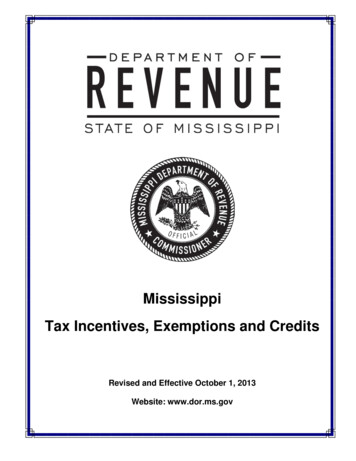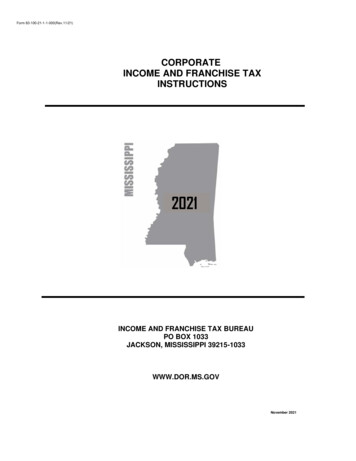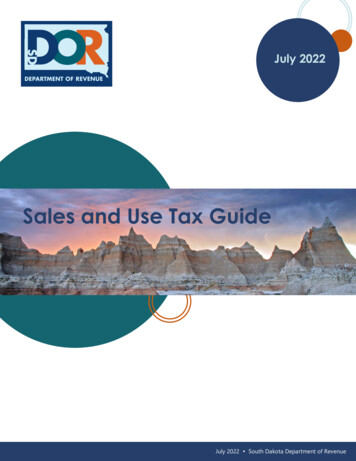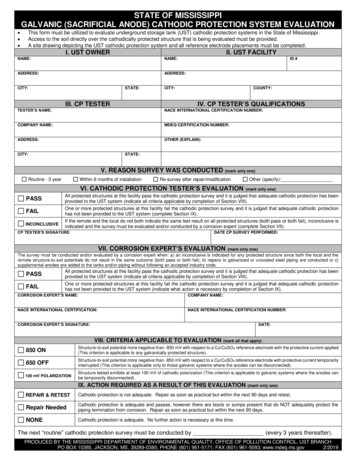
Transcription
MississippiTax Incentives, Exemptions and CreditsRevised and Effective October 1, 2013Website: www.dor.ms.govPage 1 of 119
A. INCOME TAX INCENTIVES . 5A.1. JOBS TAX CREDIT . 6A.2. NATIONAL OR REGIONAL HEADQUARTERS TAX CREDIT . 12A.3. RESEARCH AND DEVELOPMENT SKILLS TAX CREDIT . 14A.4. SKILLS TRAINING TAX CREDIT . 16A.5. MBFC RURAL ECONOMIC DEVELOPMENT (RED) BOND TAX CREDIT . 19A.6. AD VALOREM TAX CREDIT . 21A.7. EMPLOYER PROVIDED DEPENDENT CARE TAX CREDIT . 22A.8. EXPORT PORT CHARGES TAX CREDIT . 24A.9. IMPORT PORT CHARGES TAX CREDIT . 25A.10. AIRPORT CARGO CHARGES TAX CREDIT. 26A.11. INCOME TAX EXEMPTION FOR GROWTH AND PROSPERITY (GAP) AREAS . 27A.12. BROADBAND TECHNOLOGY TAX CREDIT . 31A.13. MANUFACTURING INVESTMENT TAX CREDIT . 33A.14. MISSISSIPPI EQUITY INVESTMENT (NEW MARKETS) TAX CREDIT . 35A.15. INCOME TAX EXEMPTION FOR CLEAN ENERGY BUSINESS ENTERPRISES. 37A.16. INCOME TAX EXEMPTION FOR AEROSPACE INDUSTRY ENTERPRISES . 41A.17. ENTERTAINMENT DISTRICT INCENTIVE . 45A.18. HEALTH CARE INDUSTRY ZONE INTCENTIVE . 48B. FRANCHISE TAX INCENTIVES . 50B.1. FRANCHISE TAX EXEMPTION FOR GROWTH AND PROSPERITY (GAP) AREAS . 51B.2. BROADBAND TECHNOLOGY TAX CREDIT . 55B.3. FRANCHISE TAX EXEMPTION FOR CLEAN ENERGY BUSINESS ENTERPRISES . 57B.4. FRANCHISE TAX EXEMPTION FOR AEROSPACE INDUSTRY ENTERPRISES . 62C. SALES / USE TAX INCENTIVES . 66C.1. SALES / USE TAX EXEMPTION FOR CONSTRUCTION OR EXPANSION . 67C.2. SALES / USE TAX EXEMPTION FOR TRANSFER OF NATIONAL OR REGIONAL HEADQUARTERS . 69C.3. SALES / USE TAX EXEMPTION FOR BOND FINANCING . 71C.4. SALES / USE TAX EXEMPTION FOR BUSINESSES IN GROWTH AND PROSPERITY (GAP) AREAS . 74C.5. SALES / USE TAX EXEMPTIONS FOR BROADBAND TECHNOLOGY . 76C.6. SALES / USE TAX EXEMPTION FOR CLEAN ENERGY BUSINESS ENTERPRISES . 78C.7. SALES / USE TAX EXEMPTION FOR AEROSPACE INDUSTRY ENTERPRISES. 81C.8. SALES / USE TAX EXEMPTION FOR DATA CENTER ENTERPRISES . 83C.9. SALES/USE TAX EXEMPTION FOR BUSINESSES IN HEALTH CARE INDUSTRY ZONES . 85D. REBATE INCENTIVE PROGRAMS . 87D.1. ADVANTAGE JOBS INCENTIVE PROGRAM (ADVANTAGE JOBS) . 88D.2. SALES / USE TAX REBATE FOR TOURISM . 92D.3. MOTION PICTURE PRODUCTION INCENTIVE . 94D.4. SMART BUSINESS REBATE . 97E. PROPERTY TAX INCENTIVES. 99E.1. INDUSTRIAL EXEMPTIONS . 100E.2. FREE PORT WAREHOUSE EXEMPTION . 102E.3. AD VALOREM EXEMPTION FOR GROWTH AND PROSPERITY (GAP) AREAS . 103E.4. AD VALOREM EXEMPTION FOR BROADBAND TECHNOLOGY EQUIPMENT . 104Page 2 of 119
MS Tax IncentivesOctober 2013F. APPENDICES .106F.1. DEFINITIONS . 107F.2. CONTRACTOR’S TAX . 109F.3. COUNTY TAX ASSESSOR OFFICES . 111County Tax Collectors . 112F.4. COUNTY RANKINGS BY YEAR. 1132013 . 1142012 . 1152011 . 1162010 . 1172009 . 118Page 3 of 119
MS Tax IncentivesOctober 2013Mississippi Tax Incentives, Exemptions and CreditsMississippi is committed to encouraging businesses to establish or expand businesses and increase the employment ofindividuals in the State. To help businesses, Mississippi has authorized several tax incentives, including tax exemptionsand credits. These incentives will give an economic benefit to those businesses which are eligible. Some incentiveshave a greater financial benefit when locating in a lesser developed county. Other incentives give greater benefits whenemploying the more technical positions or the more highly compensated positions in Mississippi.Most of the incentives require advanced approval either by the Mississippi Development Authority (referred to from thispoint forward as MDA), the Mississippi Business Finance Corporation (referred to from this point forward as MBFC) or bythe Mississippi Department of Revenue (referred to from this point forward as MDOR) or by local governing authorities(referred to from this point forward as County or City) or a combination. In this book, the incentives, exemptions andcredits are grouped by the tax type.Each incentive, whether exemption or credit, will have a description, the types of businesses eligible for the incentive,and what is required to claim the incentive. Also included are the code sections that authorize the specific incentive. Allreferences to the code sections will be attributed to the Mississippi Code Annotated, as amended (referred to from thispoint forward as Miss Code Ann).You can locate the code sections at the following web PORTANT!!!Detailed records must be maintained on any information used to calculate any incentive benefit.These records may be requested to be presented to a representative of the MDOR upon audit or to be attached to aspecific application or tax return. If adequate records are not available to verify exemptions, credits or other incentivebenefits, the incentive may be revoked. Also, if, after approval has been given on any economic incentive, there isrevealed any material omission or misstatement of fact or fraudulent representation, the incentive may be revoked. Anyfinancial benefit as a result of either of the two situations mentioned above may be required to be paid back to the state.References will be made to various state agencies throughout this book. The agency and the abbreviated reference,along with their associated web site, are listed below. These abbreviated references will be consistent while you readthe different incentive opportunities available to businesses in Mississippi.Mississippi Development AuthorityMississippi Business Finance CorporationMississippi Department of RevenueMississippi Secretary of StateMississippi Department of Employment Security(MDA)(MBFC)(MDOR)(MSOS)(MDES)Page 4 of .dor.ms.govwww.sos.state.ms.uswww.mdes.ms.gov
MS Tax IncentivesOctober 2013A. Income TaxIncentivesPage 5 of 119
MS Tax IncentivesOctober 2013A. 1. Jobs Tax CreditAn income tax credit is available for a five (5) year period equal to a percentage of payroll for each newly created job ofan eligible business. A minimum number of jobs must be created to receive the credit. The eligible businesses include: manufacturers processors distributors wholesalers research and development warehousesThe following types of businesses require a designation from MDA prior to taking the Jobs Tax Credit: air transportation and maintenance facilities movie industry studios telecommunication enterprises data or information processing computer software developers any technology intensive facility recreational facilities that impact tourism final destination or resort hotels with more than 150 guest roomsEXCEPTION: No business for the transportation, handling, storage, processing or disposal of hazardous waste iseligible to receive this credit.JOBS TAX CREDIT (Credit Code 05)The Jobs Income Tax Credit is a credit that is available to businesses that increase employment by a specified minimumamount. The minimum amount depends on the location of the jobs created. It is not available to businesses that movefrom one location within the state to another location within the state without increasing employment.The amount of the credit is based on the number of new jobs created and the county where the jobs are created. Jobscreated in less developed counties are eligible for a greater percentage of payroll for each job created while fewer jobsare needed to establish the minimum. The credit is good for a period of five (5) years. This credit may be used incombination with any of the other credits. However, the total of the Jobs Tax Credit, the National or RegionalHeadquarters Tax Credit and the Research and Development Skills Tax Credit is limited to fifty percent (50%) of theincome tax liability attributable to the income derived from operations in this state for that year. Any credit claimed butnot used in a taxable year may be carried forward for five (5) years.Each year the MDOR ranks the counties in Mississippi as Tier Three (less developed), Tier Two (moderately developed),and Tier One (developed). The counties are evaluated and ranked based on the unemployment rate and per capitaincome of each county. They are then divided into the three previously mentioned groups with one-third of the countiesin each group. This ranking is used to determine the minimum number of jobs a business must create in a given yearbefore it qualifies for the credit and the amount of credit per job allowed. The ranking for a specific county can changefrom year to year based on this evaluation. The amount of Jobs Tax Credit per employee and the job levels for eachcounty ranking are as follows:County RankingTier One (developed)Tier Two (moderately developed)Tier Three (less developed)Minimum Annual Increase in No. of Jobs201510Credit Per Job2.50% of payroll5.00% of payroll10.00% of payrollThe number of jobs must be created within one (1) year and is measured at the end of the fiscal year. To determinewhen the new full-time jobs are created, the business compares the average number of full-time positions in one fiscalyear with the average for the prior year. When dealing with a short period, compare the short period to the same periodof the prior year. Jobs cannot be accumulated over several years to qualify. The credit is available for each net new fulltime job created as long as the minimum number has been achieved and maintained. The credit is for full-time positionsonly. Part-time jobs may not be combined to add up to a full-time job. The credit is based on filled positions and theemployees must be employed in this state and subject to Mississippi Withholding Tax. A “full-time job” is a job of at leastthirty-five (35) hours a week and includes leased employees from an entity that is in the business of leasing employeesas long as all other requirements are met.Page 6 of 119
MS Tax IncentivesOctober 2013The credit may be taken each fiscal year for five (5) years beginning in years 2 through 6 after the creation of the jobs.The year the jobs are created is Year 1.Example: A manufacturer expands and creates 50 new jobs in a developed county. The minimum number of jobs in adeveloped county is 20 and the amount of credit per job is 2.5% of the payroll of those 50 new jobs. The payroll forthose new jobs equals 2,500,000. The credit available for the 50 jobs would be 62,500. The credit can be used inYears 2 through 6 on the taxpayer's income tax return. Credit is available each year (Years 2 - 6) for the 50 jobscreated, plus any unused credit that has been carried forward.The Jobs Tax Credit is earned at a given level of employment for one five (5) year period. If, after qualifying for one five(5) year period, the business increases the number of jobs substantially enough to qualify again for another five (5) yearperiod, they may apply for a second five (5) year period. Each five (5) year period is accounted for separately.Jobs created within an existing (5) five year period that do not meet the minimum number of jobs required to qualify foran additional (5) five year period are allowed to be included within the existing (5) five year period.If the number of jobs falls below the minimum required within a year, the credit is lost for that year and cannot berecovered. If the minimum number of jobs is achieved again, the credit is available for the remainder of the original five(5) year period. The original period is not extended. There are no recapture rules for the credit taken prior to the periodof time that the number of jobs fell below the minimum.Same OwnershipIf an employer constructs a new facility or expands an existing facility, without other decreases in employment, then thefacility would qualify for the jobs tax credit as long as the other requirements are met.If an employer retains ownership of a facility that has been shut down for five (5) years and then is reopened, evenproducing the same or similar product, any increases in employment will create the jobs tax credit as though it is a newfacility. If the facility is closed for less than five (5) years, then the jobs tax credit is not available until the employmentlevels exceed the previous peak levels. Exceptions may be considered on a case by case basis.If an employer retains ownership of a facility and replaces some, or all, of the existing equipment, but makes the same ora similar product, then the base employment level is not affected by the equipment replacement.If an employer closes an old facility and opens a new facility making the same or a related product, then the employmentlevel at the old facility would be used to determine whether employment increases at the new facility qualify for the jobstax credit.If an employer retains ownership of a facility, suspends operations and retools the production floor with ninety-fivepercent (95%) new equipment that makes a new product not similar to the old product, then the facility will be treated asa new facility.Different OwnershipIf an employer sells a plant to a related party, then the related party will be treated the same as the employer.If an employer sells a facility to an unrelated third party, and the new owner continues the old operations, then the newowner must exceed the old owner’s peak employment by a qualifying increase in order to receive any jobs tax credit.If an employer sells a facility to an unrelated third party and the new owner suspends operations to retool the productionfloor, then the facility will be treated as a new facility for the new owner. However, the retooling must include replacingninety-five (95%) of the equipment to make a new product that is not similar to the old product.If an employer ceases operations at a facility for a year or more and sells the facility to an unrelated third party, then thePage 7 of 119
MS Tax IncentivesOctober 2013facility will be treated as a new facility for the new owner, even if the same or a similar product is being made. If the newowner has shut down a facility with similar operations at the same time, then the facility will not be treated as a newfacility. If a completely different product is being made, the one-year shut down requirement may be shortened. This willbe considered on a case by case basis.If, in any of the above examples, the facility requesting the incentive produces a product that was manufactured at afacility that was closed, then the requesting facility will not earn the jobs tax credit unless the employment levels exceedsany previous high at the closed facility. If the requesting facility is located in this state, it will be able to earn the jobs taxcredit, but only to the extent that its level of employment plus the level of the original location (up to any previous highlevel of employment at the old location before the closing or retooling level) combined is in excess of any previous highlevel of employment at the original location. The definition of original product will include upgrades and modifications ofa normal product line.Calculating the Minimum Number of Jobs to QualifyTo determine whether a business at an existing facility has created the minimum number of jobs to qualify for the credit,a comparison of the average annual employment level for the previous year with the average annual employment in thecurrent year must be made. If the amount of the increase exceeds the minimum required, then the business wouldqualify for the credit. This allows the credit for businesses that have not constructed a new facility, but have substantiallyincreased employment at an existing facility.To determine whether a business with a construction for a new facility qualifies for the credit, the average employmentfor the portion of the year after production was started should be compared with the same period for the previous year. Ifthe increase exceeds the minimum, then the business would qualify for the credit.Example: A business whose fiscal year ends in December begins doing business in Mississippi and constructs a newfacility that starts up on June 1, 2010. To determine whether the business qualifies for the credit, June throughDecember of 2010 should be compared to June through December of 2009. If the increase meets the minimumrequirement, then the business would qualify for the credit.The construction of a new facility includes the actual “bricks and mortar” construction of a new building or the expansion(as defined above) of an existing facility that has been purchased by a business establishing a new presence in the area.Only the business that actually created the jobs qualifying for the credit can receive the credit. Credit received by apartnership, LLC or an S-Corporation may be passed through to only offset tax due from the activity that created thecredit. The credit is subject to the same limitations that the pass through entity would have had. The tax due on salariesor wages paid by an S-Corporation and guaranteed payments to partners by a partnership cannot be offset by the credit.The sale, merger, acquisition, reorganization, bankruptcy or relocation from one county to another county withinMississippi of any business may not create new eligibility in the current or any succeeding business entity, but anyunused credit may be transferred and continued by any transferee of the business. A letter detailing the factssurrounding such an occurrence and requesting a ruling on the eligibility of any credits must be presented to the MDORto determine whether qualifying net increases have occurred or proper transfers of credit have been made. The MDORmay require additional information as needed for substantiation and qualification.Transition between Old and New CreditThe law was changed effective for tax years ending after January 1, 2005. For taxpayers who earned the credit in taxyears prior to the effective date of the change, the amount of the credit is based on a stated dollar amount per job. ForTier 1 counties, the amount was 500 per new job; for Tier 2 counties, the amount was 1,000 per new job; and for Tier3 counties, the amount was 2,000 per new job. If, after qualifying for one five (5) year period prior to the effective dateof the change, the business increases the number of jobs substantially enough to qualify again for another five (5) yearperiod for a tax year ending after January 1, 2005, the taxpayer may apply for a second (5) year period which would thenbe accrued under the new percentage rates instead of the stated dollar amount per job. However, if the initialqualification for the credit occurred prior to the effective date of the law change, the amount of the credit will continue toPage 8 of 119
MS Tax IncentivesOctober 2013be based on a stated dollar amount per job within the five (5) year period even for jobs created after the January 1, 2005change. For example – in a Tier 1 county, 20 or more jobs must be created in a single year for tax years ending on orafter January 1, 2005 before the percentage of payroll amounts can be used. For jobs qualified prior to the effective dateof the change, the stated dollar amount per job should be used.Extension of the Credit PeriodIf the permanent business enterprise is located in an area that has been declared by the Governor to be a disaster areaand as a result of the disaster the permanent business enterprise is unable to maintain the required number of jobs, theCommissioner of the Department of Revenue may extend this time period for not more two (2) years. The extensionmust be authorized in writing by the Commissioner.JOBS TAX CREDIT FOR ECONOMICALLY DISTRESSED COMMUNITIES (Credit Code 05)There is a jobs tax credit for businesses operating in an “economically distressed community” as certified by the MDORin lieu of the basic Jobs Tax Credit previously defined. This credit is available to the same types of businesses which areeligible for the basic Jobs Tax Credit. These businesses must create at least 10 new full-time jobs and be located in anarea within a city where thirty percent (30%) of the residents are below the national poverty level and where theunemployment rate is 1½ times the national average. The MDOR must certify both the area and the business before theEconomically Distressed Community Jobs Tax Credit can be taken. The definition of “economically distressedcommunity” is found in Miss. Code Ann. Section 27-7-22.27.For the MDOR to certify an economically distressed community, the city officials must provide to the MDOR thefollowing:1. a map detailing the area to be certified;2. copy of the documentation from the US Census Bureau proving that thirty percent (30%) of the residents arebelow poverty level;3. the state unemployment rate for the area and the national unemployment rate for the same area for the sametime period; and4. the population of the city.After receiving this information, the MDOR shall verify the information and, if all requirements are met, shall certify thearea as an economically distressed community.For the Economically Distressed Community Jobs Tax Credit, all other requirements, instructions or limitations (aspreviously defined for the basic Jobs Tax Credit) apply, except for the following: The amount of credit is equal to ten percent (10%) of the payroll of each new full-time job. The credit can offset fifty percent (50%) of the income tax liability attributable to the income generated by theoperations in this state. The business may choose when to begin taking advantage of the credit, but it must be within five (5) years of thebeginning of commercial production. The business must attach a map showing the location of the business inside the economically distressed area to theApplication for Certification for Economic Incentives described in the How to Claim the Credit paragraph below.Extension of the Credit PeriodNone.JOBS TAX CREDIT FOR BROWNFIELDS (Credit Code 05)There is a jobs tax credit for businesses which remediate contaminated property or brownfields. This credit is availableto any commercial or industrial property owner which incurs costs in the remediation process of contaminated property inaccordance with the Mississippi Brownfields Voluntary Cleanup and Redevelopment Act. There is no minimum numberof new full-time jobs that must be created.For the Brownfields Jobs Tax Credit, all other requirements, instructions or limitations (as previously defined for the basicPage 9 of 119
MS Tax IncentivesOctober 2013Jobs Tax Credit) apply, except for the following: There is no minimum number of new full-time jobs that must be created, regardless of where the property is located. This Brownfields Jobs Tax Credit cannot be taken in conjunction with the National or Regional Headquarters Creditor the Research and Development Skills Credit. The owner of the brownfields property must attach a copy of the certification from the Commission on EnvironmentalQuality of the completion of the remediation and the amount of cost incurred in the project to the Application forCertification for Economic Incentives described in the How to Claim the Credit paragraph below.Extension of the Credit PeriodIf the permanent business enterprise is located in an area that has been declared by the Governor to be a disaster areaand as a result of the disaster the permanent business enterprise is unable to maintain the required number of jobs, theCommissioner of the Department of Revenue may extend this time period for not more than two (2) years. Theextension must be authorized in writing by the Commissioner.JOBS TAX CREDIT FOR ALTERNATIVE ENERGY SUPPLIERS (Credit Code 24)There is a jobs tax credit for a business engaged in the manufacture or production of alternative energy. 50% of thefinished product of the alternative energy project must be derived from resources or products from this state.For the Alternative Energy Jobs Tax Credit, all other requirements, instructions or limitations (as previously defined forthe basic Jobs Tax Credit) apply, except for the following: A minimum of 25 new jobs must be created. The amount of credit is equal to 1,000 per new full-time job regardless of where the business is located. The business may choose when to begin taking advantage of the credit, but it must be within five (5) years of thebeginning of commercial production. The credit is good for a period of 20 years. The credit can offset 100% of the income tax liability attributable to the income generated by the alternative energyproject in this state. The Alternative Energy Jobs Tax Credit cannot be taken in conjunction with the basic Jobs Tax Credit, the Nationalor Regional Headquarters Credit or the Research and Development Skills Credit. An affidavit from the producer describing the resources and products from this state used in the production of thealternative energy and attesting to the truthfulness of the statement must be attached to the Application forCertification for Economic Incentives described in the How to Claim the Credit paragraph below.Extension of the Credit PeriodIf the permanent business enterprise is located in an area that has been declared by the Governor t
MS Tax Incentives October 2013 . Page 7 of 119 . The credit may be taken each fiscal year for five (5) years beginning in years 2 through 6 after the creation of the jobs. The year the jobs are created is Year 1. Example: A manufacturer expands and creates 50 new jobs in a developed county. The minimum number of jobs in a










